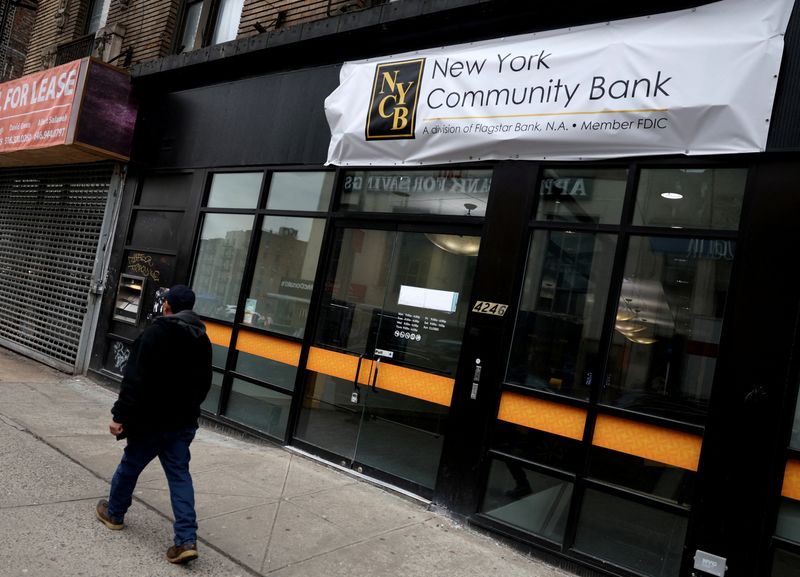By Michelle Price and Lananh Nguyen
WASHINGTON/NEW YORK (Reuters) - Investors lulled into thinking U.S. regional banks were out of the woods after ruptures last year have been given a jolt by New York Community Bank.
The under-the-radar lender's earnings report sparked a sell-off in regional bank shares in a warning for investors that had grown inured to the sector's sensitivity to high Federal Reserve interest rates nearly a year after two banks failed.
While NYCB's confluence of problems are unique to its balance sheet, elements of its earnings underscored regional lenders' ongoing sensitivity to high Fed rates which continue to squeeze commercial real estate (CRE) portfolios and lending margins, investors said.
That pressure will last longer than expected after the Fed held rates steady on Wednesday, prompting traders to reprice the first rate from March and into May, according to futures data.
"There still is an underlying business model problem that is affecting a lot of regional and community banks in a higher rate environment," Peter Orszag, chief executive of investment bank Lazard (NYSE:LAZ), said in an interview with Reuters on Thursday.
"Those problems had exited crisis levels, but they were still there," said Orszag, who previously served in the Obama administration as director of the White House budget office.
NYCB's stock has plummeted 45% in two days, while the broader KBW Regional Banking Index has fallen more than 7% this week.
The sell-off comes nearly a year after Silicon Valley Bank's March 2023 failure when high interest rates drove paper losses on its bonds, sparking a fatal deposit run that felled Signature Bank (OTC:SBNY) days later.
NYCB snapped up Signature Bank's assets, pushing its balance sheet over a $100 billion regulatory threshold that triggers strict capital and liquidity rules. That led the bank to slash its dividend to retain cash.
But NYCB also posted a $185 million loss after putting aside cash to cover two soured loans on a cooperative and an office.
"That caused the Street to be more concerned about the negative impacts for all banks," said Macrae Sykes, portfolio manager for Gabelli Financial Services Opportunities ETF, which holds several bank stocks. "You've a continuation of both factors, a more hawkish Fed and worries about commercial real estate impacting sentiment on banks."
HIT TO PROFITABILITY
The sell-off seemed to catch investors by surprise, with traders holding bullish positions in options on the SPDR S&P regional bank exchange traded fund ahead of Wednesday, Trade Alert data showed.
Other banks with high CRE exposure according to data from S&P Global Market Intelligence have also seen their shares hit, including Valley National Bank and East West Bank. The two banks did not immediately respond to requests for comment outside business hours.
NYCB's chief executive Thomas Cangemi said on an analyst call that the co-op loan was a "one off," while the bank said in its earnings release that allowing for losses strengthened its credit profile.
"We believe as the market continues to appreciate the value enhancing actions NYCB has taken the share price will recover," a NYCB spokesperson said in an email.
NYCB also reported a 16% decline in net interest income (NII), the difference between what lenders earn on loans and pay on deposits and a core driver of regional bank profits. NYCB said it expects NII in 2024 between $2.8 billion and $2.9 billion, the midpoint of which is below the $2.88 billion analysts expected, LSEG data shows.
While high rates have allowed banks to earn more on loans, they have also had to pay more to retain deposits, squeezing NII. NYCB's interest bearing deposit costs rose 29 basis points quarter on quarter, according to JPMorgan analysts.
Lower NII will contribute to "markedly lower profitability," for NYCB, Keefe, Bruyette & Woods analysts wrote.
Many other regional banks reported waning NII during quarterly earnings, and analysts expect their profitability will continue to be squeezed on rising deposit costs, Reuters reported.
Some investors, though, noted the CRE market is extremely diverse, and that not all CRE exposure is created equal. Others said many regional lenders have solid balance sheets and sufficient reserves to weather higher rates a little longer, and that the sector will benefit from the U.S. economy avoiding a recession.

"I think this is an opportunity to buy into select banks," said Tony Roth, chief investment officer at Wilmington Trust Investment Advisors, which is owned by regional lender M&T Bank (NYSE:MTB).
"Certainly, I wouldn’t buy the index because there are some regional banks that have more troubled assets than others within the commercial sector, so I think one needs to be selective."